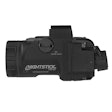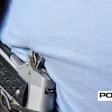Simple is usually best. From uniforms to guns, it's usually the side with the simplest stuff that wins the fight. While we've covered $2,000 1911s before, sometimes you simply don't need-or want-that degree of sophistication. There are reasons the revolver makers still sell thousands of fixed-sight .38 Special revolvers. It's because they work, and in many (most?) cases, they're all somebody needs. The same is true for a basic duty (or off-duty) pistol.
While it's nice to drive a Mercedes if you can afford it, you probably wouldn't use one as a patrol car (unless the sign on the side reads "Polizei"). In the same vein, is there really a need for a $2,000 pistol in your duty holster? Probably not, unless you have a high level of interest or are simply an aficionado of fine handguns who also happens to wear a badge. To enjoy the simple pleasures of owning the "best" of something is a concept that I won't debate. I suffer from the affliction myself.
However, I confess, whenever I handle a basic 1911 pistol, either an original commercial Colt from 1918 or a more modern gun, I'm quickly reminded of just why this elegantly simple gun has been the darling of so many millions of fighting men over the decades.
The quiet authority of two pounds of steel in your hand is simply something not easily ignored. The clack-clack of that slide, the "chunky" feeling of that big .45 round chambering, and then the quiet "snick" of the safety going on means you're now ready. Designer John Browning spoke a language you understand, and he did it in 1911. It's astounding that Browning's gun still works today, still evokes those same feelings, and still performs in the 21st Century.
No Antique
I know what you're thinking. You're thinking, You can't be seriously advocating that cops consider a century-old design for a duty gun? You bet I am.
And I'm not alone. There is a minor groundswell building in American policing, with more and more agencies adopting single-action 1911s for duty use. Interestingly, the archly conservative San Diego Police Department (my alma mater) has, under the leadership of a new chief, made inroads toward the adoption of the .40 S&W and the .45 ACP (in addition to the existing nines), and is seriously considering allowing the 1911 for uniformed duty carry.
I used to think that Hell would surely freeze over before the San Diego PD allowed 1911s-but it might. After all, if an agency allows Glocks with a five-pound trigger (essentially a cocked revolver in your holster), why would it hesitate with a design that has both a grip safety and an external manual safety?
As long as the decision to move toward a 1911 design is based upon a complete package consisting of transition training, the realities of ballistics (the .45 ACP isn't really appreciably better than either a .40 or a high-performance nine), an understanding that higher levels of recoil may hinder effective handling by some officers, and the need for specific holster designs-then all will go well. The ability to hit quickly, reliably, and effectively with the single-action 1911 is legendary, but it doesn't happen magically. It takes hard work, training, and good equipment.
Lifetime Gun
The Springfield Arms Mil-Spec 1911 is good equipment. This is an all-steel pistol and feels like it. With the proliferation of plastic, titanium, and aluminum, we've gotten spoiled and found ourselves not having to hitch up our duty belt as often. But for sheer durability and function, steel is a good thing. That's probably why they build aircraft carriers and battleships out of it. Just pick it up and you know this gun will last a lifetime (or two or three).
A quick overview of the 1911's design is in order. A classic "single-action" auto, the design originated from the fertile mind of John M. Browning. If you've ever heard of the Browning .30- and .50- caliber machine guns, you'll know who we're talking about. Browning was the world's greatest gun designer, and his Browning Automatic Rifle (BAR), Winchester Model 1886 45-70, Winchester 1892, Browning Auto 5 shotgun, and others, are some of the best firearms ever made. Don't believe me? Consider this: When the army went to war in Iraq last year, M2 Browning .50s played an important role. Browning's good ideas live long lives, and the 1911 is one of them.
Springfield Arms' Mil-Spec 1911 is based on a slightly revised version of the original 1911. In 1926, Colt made some design changes to meet the needs of the military. The hammer spur was shortened slightly, and the grip safety tang lengthened to minimize hammer "bite." The trigger was shortened to decrease reach, the mainspring housing was rounded slightly to force the muzzle up a bit when the gun was gripped, and the sights were updated with a bolder, easier to see design. This is the model the Springfield emulates, and emulates well.[PAGEBREAK]
The old military 1911s had a reputation for poor accuracy and loose construction. Some of it is true and some of it isn't. While those with many thousands of rounds may have gotten sloppy, a good condition military 1911 will easily shoot five inches at 25 yards. But the old version's trigger pulls can be terrible and may have contributed to "poor accuracy" complaints.
Trust me. The Springfield has no such problems. Our test gun had a sterling trigger pull, measured at an honest, silky smooth four pounds with an RCBS trigger-pull gauge. While a "military" pistol, the Springfield showed excellent fit, and there was nothing we could even remotely consider "slop" when it came to function. The parts fit well, the safety "snicked" on and off neatly, and all the widgets worked as advertised.
I also noticed that the grip frame seemed to be slightly beefier in the front-strap portion. A quick check against an original Colt confirmed my observation. The edges are a bit "squarer," and it appears the front strap is actually a few thousandths thicker. This doesn't hurt a thing, and as a matter of fact, it makes checkering the grip frame easier.
Other than this one minor point, this gun is all 1911 and any G.I. from any period would feel right at home with it in his hand. The features are basic 1911. There's no firing pin safety (like a Series 80 Colt, or one of the new systems from Kimber or Springfield) that locks the firing pin until the trigger is pulled fully to the rear. A titanium firing pin is in place, which effectively prevents an accidental discharge if a loaded gun is dropped on the muzzle. But this is a classic 1911 design, and due caution needs to be exercised when handling it. Again, if you can handle a Glock or a Springfield XD, a 1911 is simple to master, so don't be put-off. The manual of arms to operate a 1911 quickly becomes second-nature.
The Mil-Spec 1911's basic parkerized finish gets the job done and will probably last as long as you own the gun. If it's good enough for the jungles of Borneo, it's probably good enough for Main Street.
This gun emanates quality, and frankly, I figured it would sell for around $650. But now comes the surprising part. Full retail is only $467. So, I imagine you'll see 'em for sale at $450 or so as the supply pipeline gets full. This is a lot of gun for the money.
Shooting Fun
On the range, the Springfield loaded and operated like a classic 1911 and there were no surprises, other than the accuracy. At 25 yards, groups hovered around the two-and-a-half-inch mark. Part of that was due to the excellent trigger pull and part due to the fit of the gun. The barrel throat is opened up slightly for reliable feeding, and I honestly did not experience any malfunctions during our shortish test. A total of around 350 rounds went downrange, and I came away very impressed.
This is a splendid entry-level 1911, or a basic, working gun for even an advanced shooter or police officer. The existing rugged, fixed sights would do just fine on patrol and in the "simple is best" frame of mind, the Springfield Mil-Spec is at the top of the pack. And the price is sure right, too.
Springfield Armory
Mil-Spec 1911 A1
Caliber: .45 ACP
Capacity: 7+1
Trigger Pull: 5 to 6 pounds (test gun 4 pounds)
Barrel Length: 5 inches
Overall Length: 8.5 inches
Weight: 36 ounces
Sights: GI Style, fixed
Sight radius: 6.25 inches
Price: $467 full retail
www.springfield-armory.com
Roy Huntington is the editor of American Handgunner magazine and a long-time Police Advisory Board member.

















